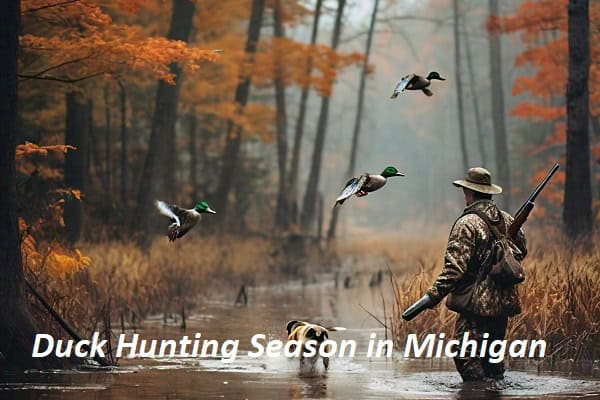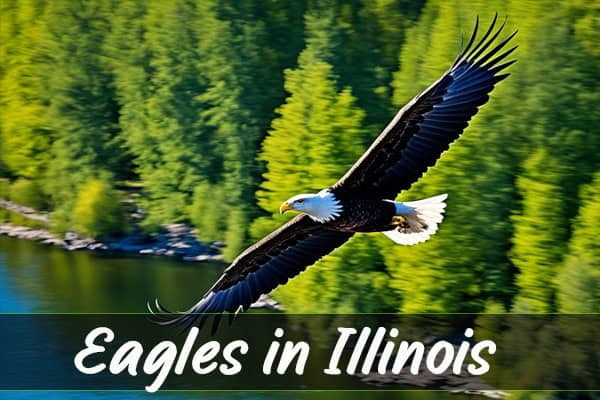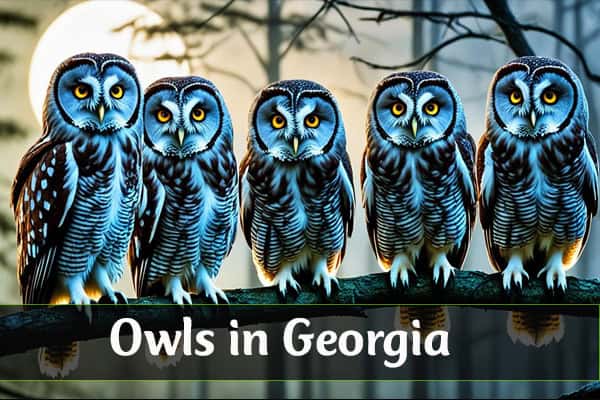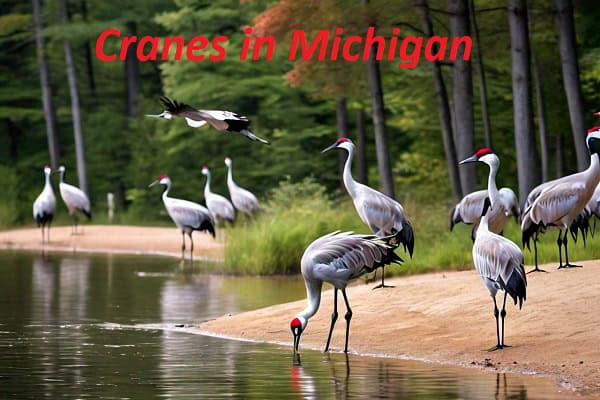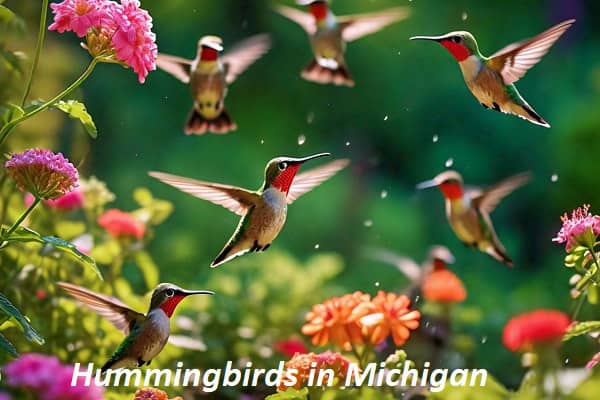6 Types of Woodpeckers in Georgia (With Pictures)
Ever wondered about the woodpeckers in Georgia? The state is home to eight unique species. Each has its own look and habits, from the bright red-headed woodpecker to the rare red-cockaded woodpecker. We’ll dive into their world and show you the best places to see them in Georgia.
The Pileated Woodpecker, Georgia’s largest, is 13.5 times heavier than the Downy Woodpecker. This size difference shows the variety among Georgia’s woodpeckers. Ready to explore Georgia’s woodpecker wonders?
1. Red-headed Woodpecker
- Scientific name – Melanerpes erythrocephalus
- Lifespan – 9 years (average),
- Size – (19 to 23 cm)
- Weight –(56 to 91 g)
- Wingspan – (35 to 43 cm)
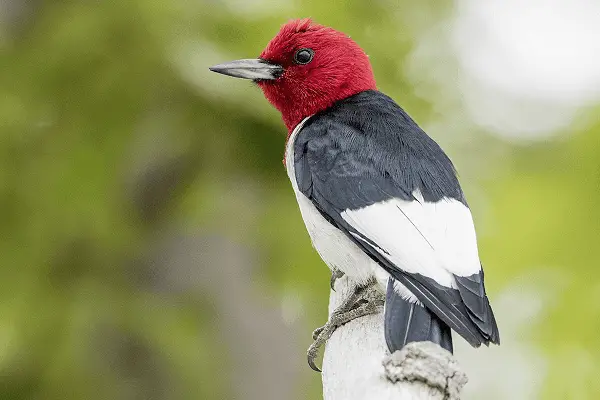
The red-headed woodpecker is a medium-sized bird with bright colors. It has a deep red head and neck, white belly, and black back with white wing patches. It makes sounds like a loud “tchurr” and a soft “charr-charr”.
Description and Identification
Red-headed Woodpeckers are about the size of a robin or a crow. Adults have a bright red head and neck, white belly, and black back with white wing patches. Young birds have a gray-brown head with black spots near the wing edges.
Nesting
They make their nests in dead trees or dead parts of live trees. They also nest in poles, living tree parts, and buildings. They don’t line their nests but use wood chips for a soft base. They might use the same nest every year and lay 3 to 10 eggs.
Diet
They eat insects like cicadas and beetles, and also fruits and seeds. Sometimes, they eat small rodents, birds, and eggs.
Where to Find Red-headed Woodpeckers in Georgia
In Georgia, you can find them in many places like grasslands and forests. They are in Harris Neck National Wildlife Refuge, Newman Wetlands Center, and the Bradley Unit of Eufaula National Wildlife Refuge all year.
| Characteristic | Description |
|---|---|
| Size | 7 to 15 inches (18 to 38 cm) in length |
| Coloration | Brightly contrasting with a distinctive deep red head and neck, white underparts, and black upper parts with large white patches on the wings |
| Beak | Stout and sharply pointed, adapted for pecking into wood |
| Habitat | Pine savannas, open forests with clear understories, grasslands with scattered trees, deciduous woodlands, swamps, farmlands, forest edges, parks, dead tree groves, and other open areas |
| Feeding Habits | Insects (one-third of diet), fruit, berries, corn, seeds, nuts, and other plant matter; occasionally small rodents, birds, and eggs |
| Nesting | Cavities in dead trees, dead areas of live trees, poles, and buildings; reuse nesting cavities annually; 3-10 eggs per clutch |
“Red-headed Woodpeckers are relatively common throughout Georgia, occurring in grasslands with scattered trees, deciduous woodlands, swamps, farmlands, forest edges, parks, dead tree groves, and other open areas.”
2. Red-bellied Woodpecker
- Scientific name – Melanerpes carolinus
- Lifespan – 9 years (average)
- Size – 23 to 27 cm
- Weight – 56 to 91 g
- Wingspan – 33 to 42 cm
The red-bellied woodpecker is a medium-sized woodpecker found in Georgia’s forests. It has a black and white body with a faint red belly. Males show off bright red on their nape and crowns.

These woodpeckers live in Georgia’s eastern woodlands all year. They like middle heights and the main branches and trunks of trees. In spring and summer, they make loud calls and can extend their tongues up to 2 inches.
The oldest red-bellied woodpecker found in Georgia was over 12 years old. Adult males are common in eastern woodlands and suburbs. But, their red bellies are often hidden by feathers. Young red-bellied woodpeckers are grayer and lack the red head markings of adults.
These woodpeckers fly in an undulating pattern through trees. They like old oak and hickory, as well as young hardwoods and pines. They also visit backyard suet feeders often.
In the early 20th century, the red-bellied woodpecker declined in some areas. But, it has been growing again, moving north. The species is stable or growing, but climate change is a threat.
“The Red-bellied Woodpecker can stick out its tongue nearly 2 inches past the end of its beak.”
| Habitat | Nesting | Diet |
|---|---|---|
| Eastern woodlands, suburban areas | Cavity nests in dead trees and dead parts of live trees | Insects, spiders, grapes, hackberries, mangoes, oranges, nuts, acorns, pine cones, seeds |
3. Downy Woodpecker
- Scientific name – Dryobates pubescens
- Lifespan – 2 years (average)
- Size – 14 to 17 cm
- Weight – 21 to 28 g
- Wingspan – 25 to 30 cm
The downy woodpecker is a small, black-and-white bird found in Georgia’s woodlands and backyards. It’s known for its black-and-white look, red nape in males, and lively nature. This makes it a favorite among woodpeckers in the state.

Nesting
These birds make their nests in cavities, digging a new one each year. They choose dead trees, parts of live trees, or fence posts. The nest is on the underside of a stub and is not used again. Inside, it’s lined with wood chips, and the female lays 3 to 8 eggs.
The eggs are kept warm for 12 days, and the young birds stay in the nest for 18 to 21 days.
Diet
Downy woodpeckers eat mostly insects like beetle larvae, corn earworms, ants, and caterpillars. They also enjoy berries, grains, and acorns. These birds do well in forests that are not too dense, thanks to forest thinning.
Downy woodpeckers are common in Georgia, showing the state’s diverse birdlife. By learning about their looks, nesting, and eating habits, we can help protect these birds. This way, we can enjoy their presence in our ecosystems.
| Woodpecker Species | Average Length | Habitat | Distinguishing Features |
|---|---|---|---|
| Downy Woodpecker | 6 1/2 – 6 3/4 inches | Forests, urban areas, backyards | Smallest woodpecker in North America, male has red patch on back of head |
| Hairy Woodpecker | 9 1/2 inches | Mature forests, suburban areas, urban parks | Larger size and longer, thicker bill compared to Downy Woodpecker |
| Northern Flicker | 12-14 inches | Open woodlands, parks, backyards | Striking black-and-white wing pattern, yellow or red-shafted feathers |
| Red-bellied Woodpecker | 9-10 inches | Forests, suburban areas, urban parks | Red crown and nape, faint red belly (males), white and black barring on back |
| Pileated Woodpecker | 15-19 inches | Large, mature forests with dead and fallen trees | Largest woodpecker in Georgia, prominent red crest, black and white plumage |
4. Hairy Woodpecker
- Scientific name – Dryobates villosus
- Lifespan – 10 years (average)
- Size – 18 to 26 cm
- Weight – 40 to 95 g
- Wingspan – 33 to 41 cm
Woodpeckers in Georgia, the hairy woodpecker is a medium-sized bird with black and white colors. It has black upperparts, white spots on the wings, and a white back. The head sports black and white stripes and the underside is white. Males have a red patch on the nape, unlike the female’s black patch. The bird is also known for its white outer tail feathers without any marks.
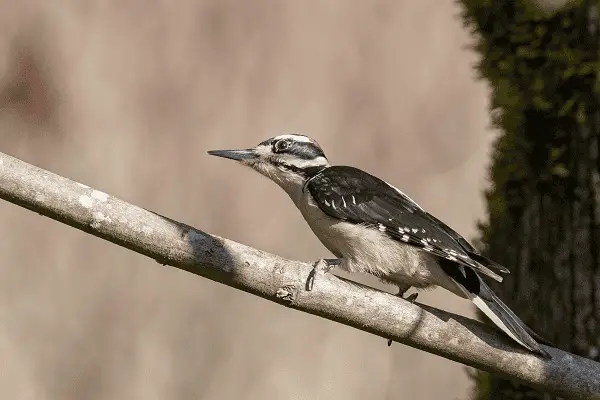
Habitat and Distribution
Hairy Woodpeckers live in many places in Georgia, like mature forests and suburbs. They also enjoy parks, cemeteries, and areas with open pine-oak woodlands. These birds are flexible and do well in both wooded and open areas, even in cities.
Nesting
They make their nests under dead stubs on live trees or in dead trees. They don’t use the same nest the next year. Females lay three to six eggs, which take 11 to 12 days to hatch. The young birds leave the nest after 28 to 30 days.
Both parents feed the young with soft insects. They are known for climbing tree trunks and sometimes foraging on the ground. This behavior makes them stand out.
The Hairy Woodpecker is not considered endangered, as its numbers have grown over the years. Its ability to live in different places, including cities, has helped it succeed. By learning about its unique traits and habits, bird lovers in Georgia can enjoy watching this interesting woodpecker.
5. Pileated Woodpecker
- Scientific name – Dryocopus pileatus
- Lifespan – 9 years (average)
- Size – 40 to 49 cm
- Weight – 250 to 350 g
- Wingspan – 66 to 75 cm
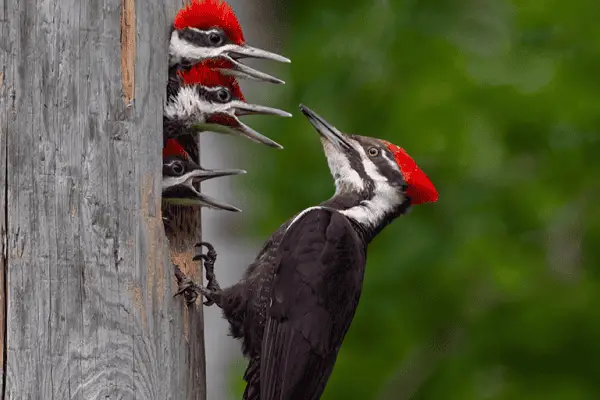
The pileated woodpecker is the biggest in Georgia. It weighs 10.5 ounces and is 17.5 inches long. This bird stands out with its bold black-and-white look, a red crest, and a long, chisel-like beak.
Where to Spot Pileated Woodpeckers
These birds live in mature forests and woodlands with big, old trees. They’re not often seen in cities but might visit feeders near forests. Great places to see them in Georgia are Piedmont National Wildlife Refuge, Kennesaw Mountain National Battlefield Park, and the Altamaha Wildlife Management Area.
6. Red-cockaded Woodpecker
- Scientific name – Dryobates borealis
- Lifespan – 12 years (average)
- Size – 20 to 23 cm
- Weight – 42 to 52 g
- Wingspan – 34 to 41 cm
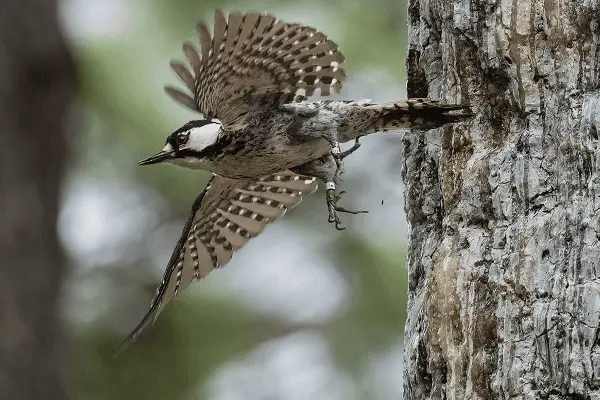
The red-cockaded woodpecker (Dryobates borealis) is a small, unique bird in the southeastern United States, including Georgia. It’s critically endangered because its home, old-growth longleaf pine forests, is disappearing.
This bird stands out with its black-and-white look, big white cheek patches, and a small red spot on the male’s head. It’s the only bird that makes its home in living pine trees. This special skill helps it live in its specific habitat.
Efforts are being made to save the red-cockaded woodpeckers in Georgia. The red-cockaded woodpecker in Georgia is being helped by the U.S. Fish and Wildlife Service, the Georgia Department of Natural Resources, and private landowners.
- Habitat Restoration and Management
- Translocation and Reintroduction
- Safe Harbor Agreements
- Monitoring and Research
Thanks to these efforts, the red-cockaded woodpecker in Georgia is slowly returning. But, it’s still in a tough spot. We must keep working hard on red-cockaded woodpecker conservation to ensure it survives.


